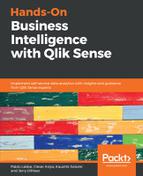Qlik's Associative Engine is a remarkably fast and flexible in-memory database that enables users to leave the old world of query-based data pulls and enter the future of true data exploration through what Qlik terms the Associative DifferenceTM. The power of the Associative Engine rests in the ability to start with the entire set of data and navigate the data not just linearly, which you may be used to in other tools, but also laterally, without having to define a path before you start your analysis. This mechanism facilitates analytics in the same way that our brains actually work; analytics is a creative process that evolves rapidly as we're performing the analysis. If you knew what answer you were looking for before you started, you wouldn't need a tool; you could just find that answer with a single query.
Consider how you find information about a restaurant: you go to your favorite search engine and type in the name of the restaurant. From there, you may explore some review sites, find the restaurant's website, take a look at the menu, and maybe you stumble on some related restaurants. One of the related restaurants catches your eye and you see they have availability through a reservation service. You then book that restaurant and go on to enjoy a fabulous meal. This is a simple use case, but it clearly illustrates how any analysis, no matter how small, is a journey and you don't necessarily know where the destination is when you start.
Qlik facilitates this creative analytics discovery process through a clever color scheme that highlights filter values throughout the application:

In the preceding screenshot, the selected field values are highlighted in green (dark gray); that is, Western in the Region filter box and Amalia Craig and Amanda Honda in the Sales Rep filter box.
The values highlighted in white are associated with or related to the selected values, that is, ActionWorld, CAPCON, and so on, in the Customer filter box.
The values highlighted in light gray are called alternative values. In other words, if I hadn't made any selections in the Region field, the remaining regions would be in white. The values highlighted in dark gray are called excluded values, which means that they are not associated with or related to selections made in other fields; in this case, the Region and Sales Rep fields.
The following screenshot illustrates this concept a little more clearly:

By selecting a few customers, I can see that Janice Scott and Samantha Allen are related to ActionWorld, GDSS, and Neostar, but are highlighted in light gray because I have made other selections in the Sales Rep field.
Conceptually, this may seem simple, but it allows us to see the whole universe of data all at once and helps our brains do what brains do best: identify patterns and irregularities. Let's say, for example, using the preceding filters, that Brad Taylor is also supposed to be covering ActionWorld. It sticks out immediately that Brad is not in the list of alternate Sales Reps. We recognize that irregularity and pivot our analysis on the fly, clicking Brad's name and digging around for why he's not selling anything to ActionWorld. In an alternative tool that doesn't have this capability, we miss this opportunity to discover, because we're only shown exactly what we've asked for:

In addition to facilitating the creative analytics process through data highlighting, Qlik Sense also enables us to rapidly traverse data in a Wonkavator-like fashion; that is, navigating the data in every possible direction. The breadcrumb trail at the top of each application shows every selection we've made and allows us to change those selections in any order we want, not just navigating backward and forward. We can go down the path of Region | Sales Rep | Customer, but we're not bound to that path; for example, we can change the Sales Rep and leave the other selections intact, or clear Region and see how that affects the Customer and Sales Rep fields. We can also lock fields, select all values, select alternative values, or select excluded values, all right from the breadcrumb bar, which is always located at the top of the screen, as seen in the following screenshots:


The flexibility of Qlik's Associative Engine complements the naturally creative process of analytics and gets us to better decisions faster. So, let's get into Qlik Sense!
